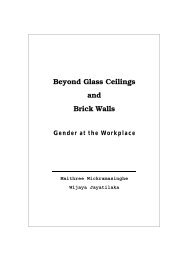SETP No. 14 The Economic Value of Incremental Employment in the ...
SETP No. 14 The Economic Value of Incremental Employment in the ...
SETP No. 14 The Economic Value of Incremental Employment in the ...
Create successful ePaper yourself
Turn your PDF publications into a flip-book with our unique Google optimized e-Paper software.
6 <strong>The</strong> Macro <strong>Economic</strong> Impact <strong>of</strong> <strong>the</strong> Local Manufacture <strong>of</strong><br />
Construction Equipment<br />
6.1 <strong>The</strong> objective <strong>of</strong> this chapter is to determ<strong>in</strong>e <strong>the</strong> macro economic impact <strong>of</strong> <strong>the</strong><br />
local production <strong>of</strong> construction mach<strong>in</strong>ery.<br />
6.2 Bell Equipment, based <strong>in</strong> Richards Bay KwaZulu Natal, is a local manufacturer <strong>of</strong><br />
construction equipment. Bell Equipment had, <strong>in</strong> pr<strong>in</strong>ciple, agreed to discuss <strong>the</strong><br />
research project and assess <strong>the</strong>ir role <strong>in</strong> <strong>the</strong> <strong>in</strong>vestigation. Unfortunately, given<br />
<strong>the</strong> competitive nature <strong>of</strong> <strong>the</strong> <strong>in</strong>dustry, <strong>the</strong>re was less enthusiasm once <strong>the</strong><br />
degree <strong>of</strong> disclosure became clear. O<strong>the</strong>r <strong>in</strong>dustry players such as Bateman<br />
Earth Mov<strong>in</strong>g Equipment, Barlows (Caterpillar) and Komatsu were approached<br />
with a similar lack <strong>of</strong> success.<br />
6.3 Because <strong>of</strong> <strong>the</strong> above constra<strong>in</strong>ts <strong>the</strong> <strong>in</strong>vestigation focussed on one form <strong>of</strong> road<br />
construction equipment – <strong>the</strong> wheeled loader. This particular piece <strong>of</strong> equipment<br />
was selected as it is one <strong>of</strong> <strong>the</strong> most important areas where we are able to<br />
substitute labour and mach<strong>in</strong>es <strong>in</strong> road construction, on <strong>the</strong> one hand, and<br />
because it is an important locally made mach<strong>in</strong>e, on <strong>the</strong> o<strong>the</strong>r.<br />
Description <strong>of</strong> Methodology<br />
6.4 In <strong>the</strong> first <strong>in</strong>stance <strong>the</strong> methodology is <strong>the</strong> identical to that applied <strong>in</strong> Section 5.<br />
<strong>The</strong> constituent capital parts <strong>of</strong> wheeled loaders were disaggregated <strong>in</strong>to key<br />
components. <strong>The</strong>se components were <strong>in</strong> turn reallocated to SIC code. <strong>The</strong><br />
potential range <strong>of</strong> import component was estimated. F<strong>in</strong>ally, us<strong>in</strong>g <strong>in</strong>put output<br />
multipliers, <strong>the</strong> macro economic impact <strong>of</strong> <strong>the</strong> local production <strong>of</strong> a wheeled<br />
loader was estimated. <strong>The</strong> model calculated <strong>the</strong> correspond<strong>in</strong>g direct, <strong>in</strong>direct,<br />
<strong>in</strong>duced and total economic effects for each imported content scenario.<br />
6.5 <strong>The</strong> model assumes that no local macro economic benefit is derived from an<br />
imported component. For example if tyres were imported, <strong>the</strong> rand value for tyres<br />
<strong>in</strong> <strong>the</strong> <strong>in</strong>put spreadsheet was entered as zero, <strong>the</strong>reby nullify<strong>in</strong>g any effects that a<br />
change <strong>in</strong> demand for tyres would have on <strong>the</strong> tyre manufactur<strong>in</strong>g <strong>in</strong>dustry and<br />
on <strong>the</strong> South African economy as a whole.<br />
Data<br />
6.6 To accomplish <strong>the</strong> revised research objectives it was necessary to establish:<br />
• <strong>The</strong> cost <strong>of</strong> wheeled loaders similar to those manufactured by Bell<br />
Equipment.<br />
• An estimate <strong>of</strong> <strong>the</strong> cost breakdown <strong>of</strong> <strong>the</strong> above wheeled loaders i.e. <strong>the</strong><br />
contribution <strong>of</strong> <strong>the</strong> various components to <strong>the</strong> total cost <strong>of</strong> a wheeled<br />
loader.<br />
• An estimate <strong>of</strong> <strong>the</strong> probability <strong>of</strong> a particular component be<strong>in</strong>g imported.<br />
6.7 Table 6.1 provides some key <strong>in</strong>formation on price and bucket capacity <strong>of</strong> a<br />
selection <strong>of</strong> wheeled loaders that are available <strong>in</strong> South Africa. Three makes <strong>of</strong><br />
wheeled loader are reported <strong>in</strong> <strong>the</strong> table – Komatsu, Caterpillar and Bell. <strong>The</strong>se<br />
range <strong>in</strong> size from 10 ton mach<strong>in</strong>es, to 13 ton mach<strong>in</strong>es and f<strong>in</strong>ally to <strong>the</strong> colossal<br />
44
















